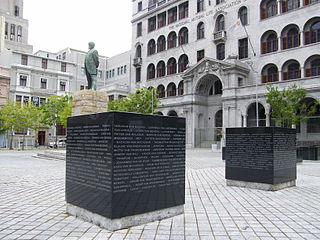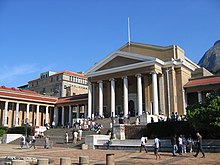
Paarl is a town with 112,045 inhabitants in the Western Cape province of South Africa. It is the third-oldest city and European settlement in the Republic of South Africa and the largest town in the Cape Winelands. Due to the growth of the Mbekweni township, it is now a de facto urban unit with Wellington. It is situated about 60 kilometres (37 mi) northeast of Cape Town in the Western Cape Province and is known for its scenic environment and viticulture and fruit-growing heritage.

Potchefstroom, colloquially known as Potch, is an academic city in the North West Province of South Africa. It hosts the Potchefstroom Campus of the North-West University. Potchefstroom is on the Mooi Rivier, roughly 120 km (75 mi) west-southwest of Johannesburg and 45 km (28 mi) east-northeast of Klerksdorp.

Kraaifontein is a town in the Western Cape province of South Africa. Organisationally and administratively it is included in the City of Cape Town Metropolitan Municipality as a Northern Suburb. The name originated from large number of crows that nest in the region.
The South African College was an educational institution in Cape Town, South Africa, which developed into the University of Cape Town (UCT) and the South African College Schools (SACS).

Tulbagh, named after Dutch Cape Colony Governor Ryk Tulbagh, is a town located in the "Land van Waveren" mountain basin, in the Winelands of the Western Cape, South Africa. The basin is fringed on three sides by mountains, and is drained by the Klein Berg River and its tributaries. The nearest towns are Ons Rust and Gouda beyond the Nuwekloof Pass, Wolseley some 15 kilometres (9.3 mi) to the south inside the basin, and Ceres and Prince Alfred Hamlet beyond Michell's Pass in the Warm Bokkeveld.
Muir College is a semi-private English medium high school for boys situated in the suburb of Vanes Estate in Kariega in the Eastern Cape province of South Africa. Muir caters for pupils from Grades 4 to 12. It is one of the oldest schools in South Africa (SA) established in 1822.

St George's Cathedral is the Anglican cathedral in Cape Town, South Africa, and the seat of the Archbishop of Cape Town. St. George's Cathedral is both the metropolitical church of the Anglican Church of Southern Africa and a congregation in the Diocese of Cape Town.

Palm Tree Mosque, or the Church of Jan van Bougies, or the Dadelboom Mosque, is a former residence and current mosque in Long Street, Cape Town, South Africa. It is the oldest substantially unaltered building in Long Street.

The Groote Kerk is a Dutch Reformed church in Cape Town, South Africa. The church is South Africa's oldest place of Christian worship, built by Herman Schuette in 1841. The first church on this land was built in 1678. Willem Adriaan van der Stel laid the cornerstone for the church. It was replaced by the present building in 1841, but the original tower was retained. The pulpit is the work of Anton Anreith and the carpenter Jacob Graaff, and was inaugurated on 29 November 1789. The Groote Kerk lays claim to housing South Africa's largest organ, which was installed in 1954 and has 5917 pipes.

The Kerk Street Mosque, also known as the Jumah Mosque, is located in Johannesburg, South Africa.

The South African Sendinggestig Museum was established in 1977 and is currently situated in the centre of Cape Town, Western Cape, South Africa. It is a province-aided museum which receives support from the Government of the Western Cape Province.

Belmond Mount Nelson Hotel is a luxury hotel at the centre of Cape Town in a garden estate overlooked by Table Mountain.

The Cathedral of Christ The King is a Catholic cathedral in Johannesburg, South Africa.

The Bertram House, located on Hiddingh Campus, of the University of Cape Town on Government Avenue, in Gardens, is the only surviving unpainted red brick two-story house left from early Georgian architecture in the city. The house has a special place in the history of the South African architecture. In 1962, it was declared a national monument, and today remains a provincial heritage site in accordance with the National Heritage Resources Act (25/1999).

Church Square in Cape Town, South Africa, lies in front of the Groote Kerk at the intersection of Parliament and Spin Streets. It currently features a park.
The South African Children's Home was a building on the end of Long Street in Cape Town. It housed the only orphanage in South Africa from its foundation in 1815 until 1923. It was the home of South African College from 1829 to 1841. After the Children's Home left the building, it was changed and dismantled piece by piece until the last remnants - part of a modern red brick building - were demolished in November 1981.
The Brixton Reformed Church was a congregation of the Dutch Reformed Church in South Africa (NGK) in the western suburbs of Johannesburg, South Africa, which was absorbed along with the Johannesburg West Reformed Church (NGK) in 1993 into the new Vergesig Reformed Church. Brixton's centrally located building continues to serve the merged congregation, which has since acquired the Langlaagte Reformed Church as well as the Crosby West Reformed Church. Around 1985, the Cottesloe Reformed Church was also absorbed into the original Brixton congregation. Around 2014, Vergesig changed its name to Brixton Church.
The Johannesburg Reformed Church was the first congregation of the Dutch Reformed Church in South Africa (NGK) to be founded in Johannesburg on August 14, 1887. All the congregations on the Witwatersrand stem from it, but by the 2010s, the NGK yearbook recorded only 90 in its ward which had long ceased to operate independently.
The Parkhurst Reformed Church was a congregation of the Dutch Reformed Church in South Africa (NGK) that was active from 1944 to 1996 in the Johannesburg suburb of Parkhurst.















